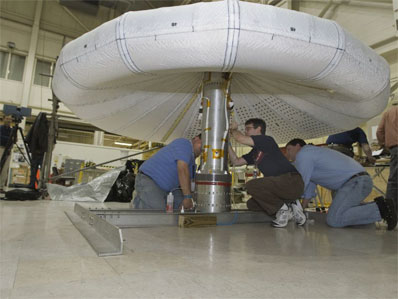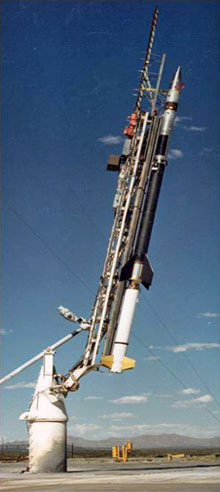
Suborbital test to aid Mars reentry system design
BY CRAIG COVAULT
SPACEFLIGHT NOW
Posted: August 16, 2009


NASA's Wallops Flight Facility will launch a major sounding rocket test of an inflatable ballutet planetary reentry system Aug. 17. The liftoff between 7-11 a.m. EDT (1100-1500 GMT) is planned shortly after Cape Canaveral is slated to launch the final Air Force Delta 2 carrying a GPS navigation satellite.

Credit: NASA
|
A Black Brant sounding rocket will be used to fire the Wallops test 130 mi. into space where it will then fall back into Earth's atmosphere achieving velocities of Mach 2.56. The entire data acquisition profile will be done during descent to measure the loads on the ballute and its deceleration rates.
Future Mars unmanned sample return missions or manned Mars flights could require the delivery of 60-80 tons of space hardware to the surface. Current aeroshell and parachute combinations can only handle about 10 tons, meaning that large ballutes will be critical for future operations on Mars,
The NASA Langley/ILC Dover Inflatable Reentry Vehicle Experiment (IRVE) looks like a giant mushroom when it's inflated. For the test, the silicon-coated Kevlar aeroshell is vacuum-packed inside a 16-inch (40.6 cm) diameter cylinder, but once it unfurls and pumped full of nitrogen it will be almost 10 feet (3 m) wide.
IRVE will launch out of NASA's Wallops Flight Facility on a Canadian built Terrier-Improved Orion sounding rocket designated the Black Brant. Second stage ignition occurs at 15 seconds into the flight with burnout at 40 seconds. The vehicle coasts for another 20 seconds after burnout to an altitude of 71 km. at which point the IRVE, telemetry module, and nosecone eject from the spent second stage.
| |

Credit: NASA
|
After another 20 seconds (80 seconds into the flight) the IRVE inflatable with separate from the telemetry module/nosecone assembly. Apogee is reached at 201 seconds into the flight at an altitude of 130 mi. At 210 seconds IRVE inflation begins and the aeroshell shape is attained prior to falling back into the atmosphere. Full inflation pressure is achieved at 325 seconds at an altitude of about 60 mi.
While descending the vehicle passes through the peak dynamic pressure at 364 seconds at an altitude of about 30 mi. and a Mach number of 2.56. The experiment will be officially concluded after that point. Water impact will occur at 1120 seconds in the Atlantic ocean about 100 mi. off Wallops. The unit will sink and no attempt will be made to retrieve it.
"We'd like to be able to land more mass on Mars," said Neil Cheatwood, IRVE's principal investigator and chief scientist of the Hypersonics Project within NASA's Fundamental Aeronautics Program. "To land more mass you have to have more drag. We need to maximize the drag area of the entry system. We want to make it as big as we can, but the limitation has been the launch vehicle diameter."
IRVE will help validate structural, aerothermal, and trajectory modeling and analysis techniques for the inflatable aeroshell system, according to Langley engineers Michael Lindell and Stephen Hughes who wrote an analysis of the program for the American Institute of Aeronautics and Astronautics.
The mission had originally been planned for launch in 2006, but delayed because of cost and technical factors.
There are, several technical challenges for inflatable aeroshells. The fact that inflatables are flexible structures could lead to unpredictable drag performance or aero-structural dynamic instability. High pressure needs to be maintained inside the inflatable to maintain shape and to react aerodynamic forces. Inflatables will have some level of gas leakage and, depending on the rate, require a make-up gas source. Also, aerothermal heating during planetary entry poses a material challenge. Multiple thermal protection layers with high temperature capability are required which can account for a significant part of the system mass.
|



